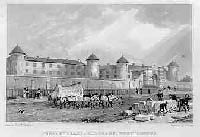Introduction to the Foundations of Tate Britain


By 1776 transportation to the New World had been interrupted by
the American War of Independence and old sailing ships known as
hulks were dragged up the Thames and stuffed with up to 70,000 prisoners.
This though was to be an 'expedient' that lasted till 1859. In 1779
the government introduced an Act which created a new form of hard
labour for prisoners in the hulks. It commenced with dredging the
river Thames - a profitable precursor to expanding trade with the
colonies - and made provision for building Millbank penitentiary
amongst others.
The penitentiary was the largest in Europe. It became the 19th
Century cesspit for containing the rowdiest of the political mob.
Henry James, who visited the prison in 1884, made use of his visit.
In the novel 'The Princess Casamassina' (1886) he has Miss Pynsent
describe the "brown, bare, windowless walls, ugly, truncated pinnacles
and a character unspeakably sad and stern. It looked very sinister
and wicked, to Miss Pynsent's eyes, and she wondered why a prison
should have such an evil air if it was erected in the interest of
justice and order... it threw a blight on the face of the day, making
the river seem foul and poisonous." As with today, there was considerable
delay in government building programmes.
Transportation to Australia, made possible in 1787, began to relieve
the pressure on the stinking hulks. It was not until 1817 that Millbank
penitentiary finally opened. A convict at this time was stripped,
shaven and sentenced to penal servitude, not imprisonment, and spent
the first nine months of their sentence in solitary confinement.
Before the birth of the prisons, punishment was an open display
of power: public executions, floggings, disembowelling etc. The
worry of the time was that such overt displays had become a source
of contention to the mob and public order was threatened in various
ways. Parliament, therefore, detached punishment from the public
gaze and into prisons. Middle class society increasingly condemned
the poor as products of their own low and immoral natures and, in
1834, the Poor Law was introduced, in which Disraeli announced to
the world "that in England poverty is a crime". Other
comments of the time condemned the poor as a vast heap of social
refuse, the "mere human street-sweepings" who "serve as manure
to the future crime-crop of the country". The main view of the ascendant
middle class was that the poor existed beyond the farthest reaches
of civilized, art-loving society and were an indolent, ignorant,
degraded, criminalised sub-race. These views were structured into
science by, amongst others, Beddoe, a future president of the Anthropological
Institute.
A racial or quasi-racial view of the poor was not the only one.
Liberals, believing in the 'levelling-up' theory (that the labourer
would emulate the artisan) dwelt upon the possibility of teaching
even the lowest the virtues and satisfactions of self-help. The
liberal elite of the mid and late 19th century put their faith in
the new persuasive power of the museums amongst other things such
as schools and public parks. The birth of museums became a complement
to prisons. The museum then, as now, provided a mechanism for the
transformation of the crowd into an ordered and, ideally, self-regulating
public. The democratic education of the mob was an attempt to addict
them to the aspirational tastefulness of Victorian society. For
the new social elite, sharing what had previously been private,
exposing what had been concealed, became a totem of progressiveness.
The Tate, with a more or less free admission policy, surgically
removed the decadence and tyranny before offering the morsels of
taste generated under previous forms of social control. The museum
provides a solution to the social chaos of the street: a site where
bodies, constantly under surveillance, could be rendered docile
through exposure to Gainsborough, Turner and Hogarth, instead of
the jailer's whip and bludgeon. If the prison changed you through
discipline and punishment, then the museum was a way to show and
tell so that you might look and learn. Here, the purpose was not
to know about people's culture but to address people as the subjects
of that culture; not to make the population visible to power but
to render power visible to the people and, at the same time, to
represent to them that power as if it were their own. The museum
became, and is still, a technical solution to the problem of displaying
wealth and power without the attendant risks of social disorder.
Further reading: 'The Political Rationality of the Museum', Tony
Bennett
The Tate is a family of galleries and operates on four sites in different parts of Britain:
Tate Britain, located at Millbank, London, founded in 1897
Tate Modern, located at Bankside, London, founded 2000
Tate Liverpool, located in the Albert Docks, Liverpool, which opened in 1988
Tate St Ives, located on Porthmeor Beach, St Ives, which opened in 1993
To learn more about the history of the Harwood De Mongrel Tate
Web site read the FAQ.
In order to provide increased display space and to offer improved services to visitors, the Tate has embarked on an ambitious programme of development and expansion: the creation of the new gallery, Tate Modern at Bankside, the development of Tate Britain at Millbank, the expansion of Tate Liverpool and the continuing development of Tate St Ives.
The Tate is a pilot museum for the 
|







